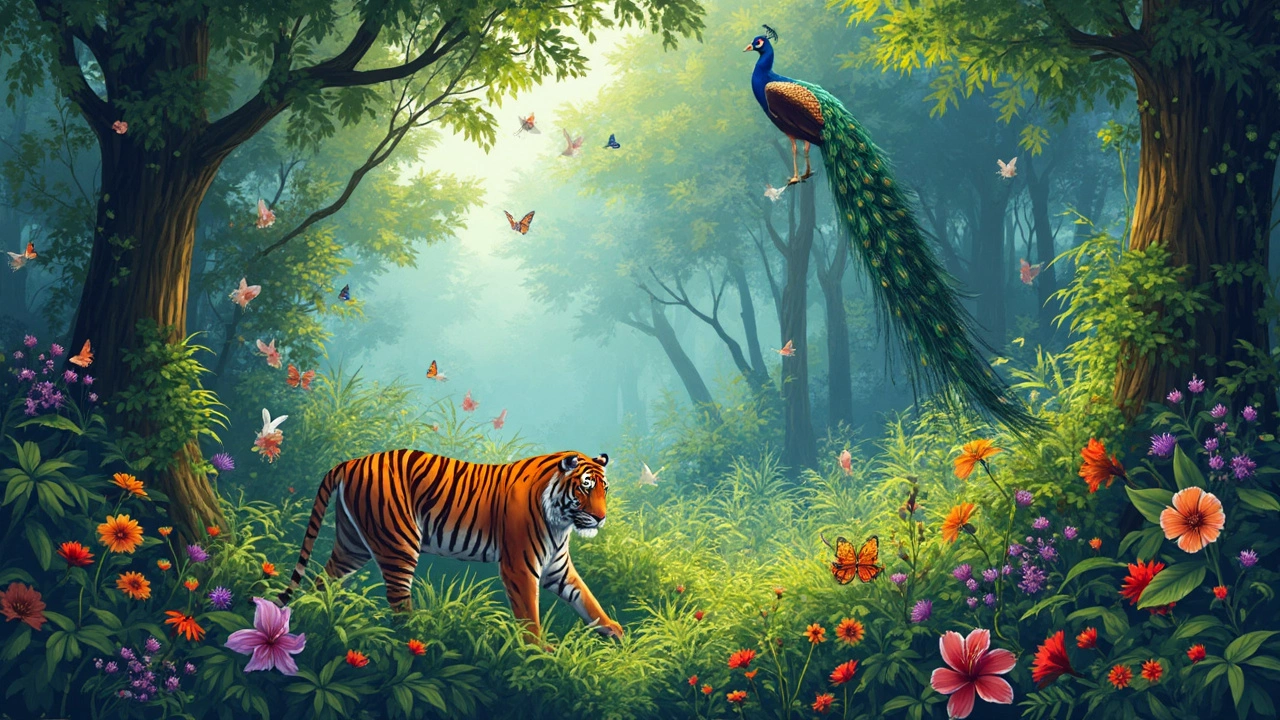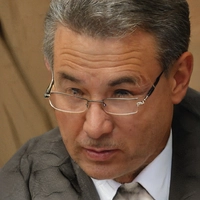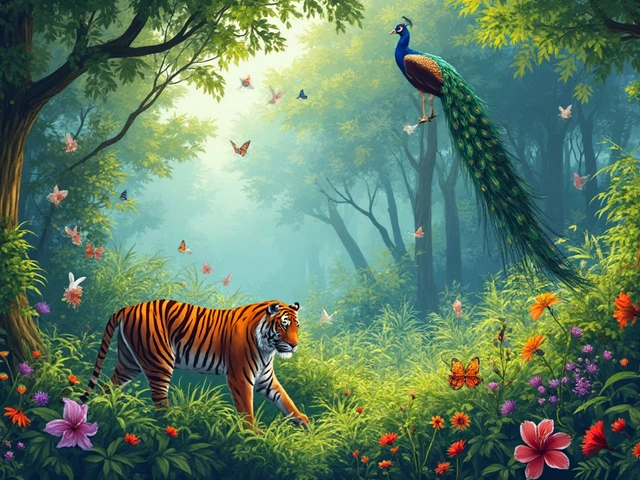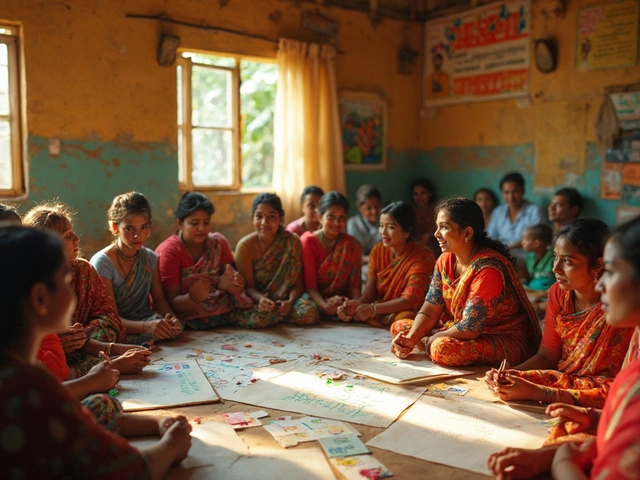Ever wondered how nature's many pieces fit together neatly into the whole picture? We're gonna unravel the six levels of organization in the environment, a framework scientists use to understand life's layers on our planet.
We start at ground zero—individual organisms. Think of a single tree in your backyard or a squirrel racing up that tree. Each has a unique role, a way of life, and specific needs. Not only do they exist on their own, but they also form the foundation for everything bigger in the environmental hierarchy. It's these individuals that crowd together to form our next level—populations.
By the time we reach communities and ecosystems, things get a bit more complex. Communities are just various populations living side by side. That lush forest or desert? It's a community teeming with different species, all interacting and sometimes competing. Ecosystems take it up a notch by adding non-living elements like water, soil, and air into the mix. It's where the living and non-living harmonize—or occasionally clash.
Individual Organisms
Let's kick things off with the building blocks of every living system—the individual organism. We're talking about a single living being, which could be anything from a bacterium to a blue whale. Each organism is a mini universe, managing its metabolism, reproduction, and response to the environment. A single tree, for instance, isn't just standing there idly—it’s photosynthesizing, providing oxygen, and possibly even communicating with other trees through root systems!
Now, why do these individuals matter so much in the big picture of environmental levels? Well, without individuals, you can't form populations, communities, or, ultimately, the biosphere. Every environmental change sprouts from how individual organisms adapt and interact with their surroundings.
The Role of Adaptation
Adaptation is a key survival strategy for organisms. Consider the Arctic fox, which is brilliantly adapted to icy environments with its thick fur and white winter coat that offers camouflage against the snow. This individual-level adaptation can influence not just the fox's survival, but also the ecosystem dynamics involving prey and predators.
The Lifecycle and Reproduction
Reproduction is another make-or-break aspect of the individual. Organisms must reproduce to sustain their populations. Take the monarch butterfly—each tiny butterfly plays a huge role in pollination. Their extraordinary migration across North America is a cycle that involves many generations, proving how individual actions can have ripple effects.
The Impact on Ecosystems
An organism doesn't exist in a vacuum. The presence or absence of a particular individual can cause shifts in an ecosystem. For example, the reintroduction of wolves in Yellowstone National Park profoundly affected river patterns, vegetation, and other animal populations—a phenomenon known as a trophic cascade.
Populations
Alright, so you've got your individual organisms down. Now, let's talk about populations. It's basically a group of individuals from the same species that live in the same area and interact with each other. Think of an ant colony or a herd of elephants. Each member of the population plays a role in ensuring the group's survival.
What's the big deal about populations, anyway? Well, they help us understand species' dynamics—like how fast a species grows, what factors control their size, and what roles they play in the ecosystem.
Population Dynamics
Population dynamics is a fancy term for the changes in population size and composition over time. Factors such as birth rates, death rates, immigration, and emigration all dance together in this complex choreography. It's like nature's way of keeping populations balanced, so no single species takes over.
Carrying Capacity and Limiting Factors
Now, here's where things get interesting. Populations can't grow forever—sorry, rabbits and kudzu. Each environment has a carrying capacity, which is the max number of individuals it can sustain without degrading. If a population exceeds this capacity, resources run dry, and the population declines.
Limiting factors are those pesky conditions that prevent populations from growing exponentially. They range from the availability of food and water to space and even disease. In essence, these factors keep populations in check and maintain ecological balance.
Real-World Impacts
Understanding population dynamics can help us tackle real-world issues, like species conservation and habitat management. For instance, if we notice a particular fish population declining, it might signal something off in their ecosystem, whether it's overfishing, pollution, or changes in climate.
Here's a quick and nifty table on some common species and their population sizes:
| Species | Approximate Population |
|---|---|
| African Elephant | 415,000 |
| Tiger | 3,900 |
| Blue Whale | 10,000-25,000 |
When it comes to environmental conservation, populations are like the heartbeat of biodiversity. By keeping tabs on them, we can ensure healthy and thriving ecosystems worldwide.
Communities
Dive into the fascinating world of communities in the environment, where groups of different populations come together and interact. Imagine a bustling forest with towering trees, underbrush, insects, birds, and mammals—all living in a web of relationships. Every species has its niche, or 'job', which helps keep the system in balance.
One important aspect of communities is biodiversity, which refers to the variety of species within a given area. Higher biodiversity often means a healthier, more resilient community that can withstand changes like climate shifts or diseases. It's like having a diverse team at work—many skills and perspectives mean better problem-solving!
Interactions
In these communities, interactions come in many flavors: competition, predation, mutualism, and more. For instance, think of a bee and a flower. The bee collects nectar and, in return, helps the flower pollinate. It's a win-win!
However, not all interactions are so friendly. Predation and competition occur when two species vie for the same resources or one species feeds on another. Both can influence population size and community structure.
Real-World Examples
- Coral Reefs: Known as the "rainforests of the sea", they are packed with diverse species, all reliant on each other.
- Amazon Rainforest: This vibrant, sprawling community is unmatched in biodiversity, housing countless species of plants and animals.
- Grasslands: Here, herbivores like zebras and bison play crucial roles, along with predators that ensure no single species dominates.
Understanding the dynamics within environmental communities can give us insight into how ecosystems function and how human actions might impact these delicate balances. So next time you take a walk in nature, think about all the unseen interactions happening in the communities around you!

Ecosystems
Alright, so you're wondering what an ecosystem really is, right? It's basically a community of living stuff interacting with their non-living surroundings. Think of it as nature's recipe—where every part serves a purpose from the tiniest bugs to the air they breathe.
Take, for example, a forest ecosystem. You've got trees, shrubs, birds, insects, all mingling within the elements like sunlight, water, and minerals. The forest is more than just a collection; it’s a symbiotic network where energy from the sun is transferred through the food chain—from the plants that absorb solar energy during photosynthesis to the animals that munch on those plants, and so on up the chain.
Energy Flow and Nutrient Cycles
Energy flow is one of the coolest parts of ecosystem dynamics. It all starts with the sun's energy getting converted into chemical energy by plants. This energy then zips through various trophic levels. Simply put, it's like a perpetual energy relay race.
Then there are nutrient cycles. This is serious business, mind you! Key nutrients (think carbon, nitrogen, and water) cycle through the ecosystem, often influenced by organisms like bacteria and fungi. They’re the unsung heroes, breaking down organic matter and enriching the soil. Without them, well, recycling would take on a whole new meaning!
Types of Ecosystems
Ecosystems come in many varieties and each has its own charm. You have terrestrial ecosystems like forests and deserts. Then there are aquatic ecosystems—rivers, lakes, and oceans which fall into freshwater and marine categories. Each one supports unique biodiversity and challenges. For instance, a pond ecosystem might contain everything from tiny algae to fish and amphibians.
Here's a quick overview:
| Type | Examples |
|---|---|
| Terrestrial | Forests, Deserts, Grasslands |
| Aquatic | Oceans, Rivers, Lakes |
Did you know? The Amazon Rainforest is considered one of the most complex and biodiverse ecosystems on Earth. It acts like a giant carbon sink that absorbs millions of tons of carbon dioxide annually.
Biomes
Now, let's talk about biomes. These are super-sized ecological categories that bundle up communities and ecosystems sharing similar climates and geography. Think of a biome as an environmental theme park, where each section—such as forests, deserts, or oceans—operates under the same climatic theme but offers unique attractions.
Ever heard of the tundra, rainforest, or savanna? Yep, those are all biomes. They span huge areas, sometimes across entire continents, and feature distinctive flora and fauna. For example, rainforests are hotbeds of biodiversity, boasting over half the earth’s plant and animal species. Compare that to the tundra, where life hunkers down to withstand incredibly harsh conditions but still thrives in its own way.
Biomes matter big time because they drive ecological cycles. Forest biomes help regulate our planet’s oxygen and carbon cycle. Deserts might seem barren, but they play a critical role in limiting plant growth, which affects global weather patterns. Here’s a cool thing: biomes can shift over time due to climate changes. What was once a fertile grassland might slowly morph into a desert.
A quick peek at how some biomes compare:
| Biome | Average Temperature (°C) | Rainfall (cm) |
|---|---|---|
| Rainforest | 20-25 | 200-450 |
| Tundra | -34 to -12 | 15-25 |
| Savanna | 20-30 | 50-150 |
Understanding biomes can help in conservation efforts. By knowing how distinct biomes function and their unique challenges, we can make smarter environmental decisions, from local conservation policies to tackling global issues like climate change.
The Biosphere
Welcome to the big picture! The biosphere is where all the magic of life happens on Earth. It's the global sum of all ecosystems, where every living thing—from the tiniest microbe deep in the ocean to gigantic whales swimming above—exists.
This level is a big deal, covering about 12 miles thick of Earth, from the deepest ocean trenches to high up in the sky where birds soar. It's not just important; it’s essential. Without the biosphere, life as we know it wouldn't exist.
Why is the Biosphere Critical?
Think about it: The biosphere is our planet's life-support system. It cycles vital elements like carbon and nitrogen, allowing life to keep on keeping on. Plants, for example, breathe in carbon dioxide and give off oxygen, while animals do the opposite. It’s a giant circle of life—literally.
And here's a cool fact: If you've ever marveled at the bright blue of the sky or the lush green of a forest, you're seeing the biosphere in action. This layer is teeming with life and constantly adapting and evolving.
Protecting the Biosphere
So why should we care about all this? Because the biosphere is under threat from pollution, deforestation, and climate change. By reducing our carbon footprint, recycling, and advocating for clean energy, we can help preserve this incredible layer of life.
| Aspect | Impact |
|---|---|
| Carbon Cycle | Essential for regulating Earth's temperature |
| Water Cycle | Supports all terrestrial life forms |
| Nutrient Cycle | Maintain the sustainability of ecosystems |
The biosphere reminds us that everything is connected. It's both a home and a community for all Earth's life. Let’s do our part to keep this global masterpiece thriving!




